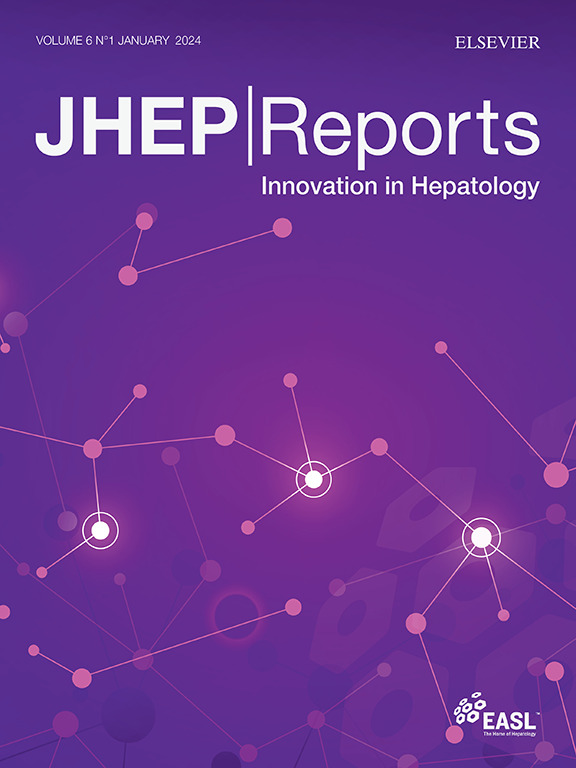Minimally invasive hepatectomy vs. thermoablation for single small (≤3 cm) hepatocellular carcinoma: A weighted real-life national comparison
IF 7.5
1区 医学
Q1 GASTROENTEROLOGY & HEPATOLOGY
引用次数: 0
Abstract
Background & Aims
For patients with single small (≤3 cm) hepatocellular carcinoma ablation is the first-line treatment, although a high rate of recurrence has been reported. The aim was to compare videolaparoscopic liver resection (laparoscopic resection group) vs. percutaneous thermoablation (ablation group) in terms of overall survival, recurrence-free survival and early recurrence in a real-life national scenario.
Methods
The study is a retrospective collection with subsequent survival analysis. Data were collected from two Italian HCC registries, ITA.LI.CA and HE.RC.O.LE.S. An inverse probability of treatment weighting analysis was performed to balance baseline differences between groups. The Kaplan–Meier method and double-robust Cox multivariable regression were run to estimate the survival and the risk of mortality and recurrence.
Results
Between 2008 and 2022, 1,465 patients were enrolled. The laparoscopic resection group and ablation group consisted of 496 and 969 patients, respectively. At baseline, the ablation group had more advanced liver disease, with higher rates of cirrhosis (90.7% vs. 77.3%, p <0.001) and Child-Pugh B status (18.4% vs. 8.8%, p <0.001). After a median follow-up of 59 months and after weighting median overall survival was 60 months (95% CI 52–66) for the ablation group and 93 months (95% CI 75–110) for the laparoscopic resection group (hazard ratio [HR] 0.607, 95% CI 0.533–0.691, p <0.001). Median recurrence-free survival was 26 months (95% CI 23–29) for the ablation group and 39 months (95% CI 30–55) for the laparoscopic resection group (HR 0.736, 95% CI 0.659–0.822, p = 0.0013). Laparoscopy was associated with a reduced risk of early recurrence (HR 0.747, 95% CI 0.655–0.853, p = 0.011).
Conclusions
This study provides real-world evidence that for patients with single ≤3 cm HCC, videolaparoscopic liver resection offers superior long-term oncological outcomes compared with thermoablation. These findings support the preference for surgical treatment in this patient population.
Impact and implications
Percutaneous thermoablation is considered an appropriate alternative to liver resection for small (≤3 cm) single hepatocellular carcinoma because of not-inferior overall survival, although several authors reported increased recurrence risk. Whether videolaparoscopic liver resection could guarantee comparable survival but superior oncologic control of the disease is a matter of debate. This study comparing videolaparoscopy vs. thermoablation in a large national cohort of 1,465 patients observed that the former guaranteed significant prolonged OS (93 months [95% CI 75–110] vs. 60 months [95% CI 52–66] for the ablation group) and recurrence-free survival (26 months [95% CI 23–29] for ablation patients and 39 months [95% CI 30–55] for laparoscopic resection patients) even after weighting all the preoperative and oncologic differences among the groups. Our results clearly address the need to rethink the role of thermoablation for single small HCC as a second-line treatment when laparoscopic liver resection is not feasible.

微创肝切除术与热消融术治疗单个小(≤3cm)肝细胞癌:加权现实生活中的全国比较
背景,目的对于单发小肝癌(≤3cm)患者,消融术是一线治疗方法,尽管有高复发率的报道。目的是比较腹腔镜肝切除术(腹腔镜切除组)与经皮热消融(消融组)在总生存期、无复发生存期和早期复发方面的差异。方法回顾性收集,并进行生存分析。数据收集自意大利的两个HCC登记处,分别是italy . li . ca和he . rc . ole . s。进行治疗加权逆概率分析以平衡组间基线差异。采用Kaplan-Meier法和双稳健Cox多变量回归估计患者的生存率、死亡率和复发率。结果2008年至2022年间,1465名患者入组。腹腔镜切除组和消融组分别为496例和969例。在基线时,消融组有更严重的肝脏疾病,有更高的肝硬化发生率(90.7%对77.3%,p <0.001)和Child-Pugh B状态(18.4%对8.8%,p <0.001)。中位随访59个月,加权后,消融组中位总生存期为60个月(95% CI 52-66),腹腔镜切除组中位总生存期为93个月(95% CI 75-110)(风险比[HR] 0.607, 95% CI 0.533-0.691, p <0.001)。消融组中位无复发生存期为26个月(95% CI 23-29),腹腔镜切除组中位无复发生存期为39个月(95% CI 30-55) (HR 0.736, 95% CI 0.659-0.822, p = 0.0013)。腹腔镜检查与早期复发风险降低相关(HR 0.747, 95% CI 0.655-0.853, p = 0.011)。结论本研究提供了真实的证据,证明对于单个≤3cm的HCC患者,腹腔镜肝切除术与热消融相比具有更好的长期肿瘤预后。这些发现支持在这类患者中首选手术治疗。影响和意义皮经热消融被认为是小(≤3cm)单肝细胞癌肝切除的合适选择,因为总生存率不差,尽管一些作者报道了复发风险增加。腹腔镜肝切除术是否能保证相当的生存,但对肿瘤有更好的控制是一个有争议的问题。这项研究对1465名患者进行了全国性队列研究,比较了腹腔镜和热消融两种方法,发现即使在加权了两组术前和肿瘤差异后,前者仍能保证显著延长生存期(消融组为93个月[95% CI 75-110],而消融组为60个月[95% CI 52-66])和无复发生存期(消融组为26个月[95% CI 23-29],腹腔镜切除组为39个月[95% CI 30-55])。我们的研究结果清楚地表明,当腹腔镜肝切除术不可行的时候,需要重新考虑热消融作为单个小肝癌的二线治疗的作用。
本文章由计算机程序翻译,如有差异,请以英文原文为准。
求助全文
约1分钟内获得全文
求助全文
来源期刊

JHEP Reports
GASTROENTEROLOGY & HEPATOLOGY-
CiteScore
12.40
自引率
2.40%
发文量
161
审稿时长
36 days
期刊介绍:
JHEP Reports is an open access journal that is affiliated with the European Association for the Study of the Liver (EASL). It serves as a companion journal to the highly respected Journal of Hepatology.
The primary objective of JHEP Reports is to publish original papers and reviews that contribute to the advancement of knowledge in the field of liver diseases. The journal covers a wide range of topics, including basic, translational, and clinical research. It also focuses on global issues in hepatology, with particular emphasis on areas such as clinical trials, novel diagnostics, precision medicine and therapeutics, cancer research, cellular and molecular studies, artificial intelligence, microbiome research, epidemiology, and cutting-edge technologies.
In summary, JHEP Reports is dedicated to promoting scientific discoveries and innovations in liver diseases through the publication of high-quality research papers and reviews covering various aspects of hepatology.
 求助内容:
求助内容: 应助结果提醒方式:
应助结果提醒方式:


